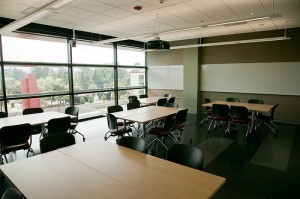Monthly Archiv: December, 2013
 Classroom organization is important for three main reasons: to maximize the opportunity for learning; minimize the occurrence of behavioral disorderly issues and establish a positive and safe environment for the students.
Classroom organization is important for three main reasons: to maximize the opportunity for learning; minimize the occurrence of behavioral disorderly issues and establish a positive and safe environment for the students.
To achieve these goals, one should consider the following. First, one should ensure that the children are sitting in a way that their focus is directed toward the teacher. Second, classroom chairs should be placed in a way that children can easily see chalkboards, screens, etc. Third, all children should be facing the front of the room, away from the windows. Fourth, the teacher should be able to see all children at all times – so their desks should be laid out accordingly.
Teachers should be able to move around the classroom with ease, so that they can monitor tasks being undertaken and behavior. There should be no blockage where teachers need to move around. Learning materials should be organized and available for teachers and children at the front of the room.
Student work should not just be displayed haphazardly; there should be a specially-delegated areas for this and children should be able to easily find and show off their work when parents come in. For both children and teachers there should be easy access to materials that are often used.
By following these simple rules, the process of achieving the three above-mentioned goals is facilitated.
When it comes to classroom organization and general management at school, there are three main mistakes teachers make:
 Many teachers have different ways of keeping their classrooms organized. But there are three basic tips that pretty much everyone should follow.
Many teachers have different ways of keeping their classrooms organized. But there are three basic tips that pretty much everyone should follow.
First, everything that is in the classroom should be following a color coded scheme. The same color should be used for all materials for each subject/unit. As well, assignments and handouts should follow this system by the use of colored copy paper. Colored labels can also work. in addition, different colored labels can be stuck on students’ resource books so that they will return the articles to the correct notebook.
Secondly everything that is used should be filed away in binders. Teacher resource books should be in three-ring binders with plastic sleeves. Again the color coding system should be used – binders should be colored-coded according to subject and articles to keep should be put in these binders as well.
Third, plastic tubs/file boxes should be used to store holiday projects, art projects, supplies etc. This kind of storage organization really reduces classroom clutter and thus keeps things much less chaotic.
There are so many ways one can organize a classroom. But with this three principle tips, one can have a great start.
 Check out this book: “Organized Teacher, Happy Classroom: A Lesson Plan for Managing Your Time, Space and Materials.” Written by Melanie S. Unger, it gives readers a fresh perspective on organizing that can encourage productivity and efficiency. It also helps them concentrate more on student achievement and worry less about keeping their classroom materials in order. Readers will find specific help with purging their unused materials and papers, creating filing systems and managing daily routines. Checklists at the end of each chapter will help readers apply key principles as they organize.
Check out this book: “Organized Teacher, Happy Classroom: A Lesson Plan for Managing Your Time, Space and Materials.” Written by Melanie S. Unger, it gives readers a fresh perspective on organizing that can encourage productivity and efficiency. It also helps them concentrate more on student achievement and worry less about keeping their classroom materials in order. Readers will find specific help with purging their unused materials and papers, creating filing systems and managing daily routines. Checklists at the end of each chapter will help readers apply key principles as they organize.
 In the classroom, students have to get from A to B. A being the beginning of the academic year and B being the following academic year. Thus an organized classroom is vital for success. It is important that a lack of chaos is present. Classroom management and student achievement often go hand-in-hand. Indeed, according to a 2003 study conducted by Sokal, Smith & Mowat, the majority of teachers – irrespective of their experience in the field – view classroom management as a high priority and an area of concern.
In the classroom, students have to get from A to B. A being the beginning of the academic year and B being the following academic year. Thus an organized classroom is vital for success. It is important that a lack of chaos is present. Classroom management and student achievement often go hand-in-hand. Indeed, according to a 2003 study conducted by Sokal, Smith & Mowat, the majority of teachers – irrespective of their experience in the field – view classroom management as a high priority and an area of concern.
One way of facilitating classroom organization is by looking at how other, more experienced teachers have accomplished this. As well, reading up on the topic and seeing how children respond to different classroom layouts, can be very helpful.
Although teachers are not completely in control of their classroom environment (for example there is little they can do about physical problems in the classroom, etc.), there is still a lot they can do to make it more pleasant. And they do have control of how the classroom furniture is set out. The most effective teachers are those who invest at the start of the year on checking out the environment and figuring out what can be done to improve on it.
 Classroom organization is important for three main reasons: to maximize the opportunity for learning; minimize the occurrence of behavioral disorderly issues and establish a positive and safe environment for the students.
Classroom organization is important for three main reasons: to maximize the opportunity for learning; minimize the occurrence of behavioral disorderly issues and establish a positive and safe environment for the students.


